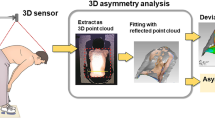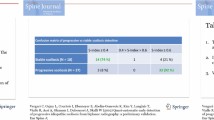Abstract
In order to reduce the observer variability in radiographic scoliosis assessment, a computer-aided system was developed. The system semi-automatically measured the Cobb angle and vertebral rotation on posteroanterior radiographs based on Hough transform and snake model, respectively. Both algorithms were integrated with the shape priors to improve the performance. The system was tested twice by each of three observers. The intraobserver and interobserver reliability analyses resulted in the intraclass correlation coefficients higher than 0.9 and 0.8 for Cobb measurement on 70 radiographs and rotation measurement on 156 vertebrae, respectively. Both the Cobb and rotation measurements resulted in the average intraobserver and interobserver errors less than 2° and 3°, respectively. There were no significant differences in the measurement variability between groups of curve location, curve magnitude, observer experience, and vertebra location. Compared with the documented results, measurement variability is reduced by using the developed system. This system can help orthopedic surgeons assess scoliosis more reliably.






Similar content being viewed by others

References
Ajemba PO, Durdle NG, Hill D et al (2007) Classifying torso deformity in scoliosis using orthogonal maps of the torso. Med Biol Eng Comput 45:575–584
Ajemba PO, Durdle NG, James Raso V (2008) Clinical monitoring of torso deformities in scoliosis using structured splines models. Med Biol Eng Comput 46:1201–1208
Allen S, Parent E, Khorasani M et al (2008) Validity and reliability of active shape models for the estimation of Cobb angle in patients with adolescent idiopathic scoliosis. J Digit Imaging 21:208–218
Canny J (1986) A computational approach to edge detection. IEEE Trans Pattern Anal Mach Intell 8:679–714
Carman DL, Browne RH, Birch JG (1990) Measurement of scoliosis and kyphosis radiographs. Intraobserver and interobserver variation. J Bone Joint Surg Am 72:328–333
Chi WM, Cheng CW, Yeh WC et al (2006) Vertebral axial rotation measurement method. Comput Methods Programs Biomed 81:8–17
Chockalingam N, Dangerfield PH, Giakas G et al (2002) Computer-assisted Cobb measurement of scoliosis. Eur Spine J 11:353–357
Cobb JR (1948) Outline for the study of scoliosis. Am Acad Orthop Surg Inst Course Lect 5:261–275
Colwell HR (1990) Radiographic measurements and clinical decisions. J Bone Joint Surg Am 72:319
Currier DP (1990) Elements of research in physical therapy. Williams and Wilkins, Baltimore
Drerup B (1984) Principles of measurement of vertebral rotation from frontal projections of the pedicles. J Biomech 17:923–935
Dumas R, Blanchard B, Carlier R et al (2008) A semi-automated method using interpolation and optimization for the 3D reconstruction of the spine from bi-planar radiography: a precision and accuracy study. Med Biol Eng Comput 46:85–92
Fitzgibbon A, Pilu M, Fisher RB (1999) Direct least square fitting of ellipse. IEEE Trans Pattern Anal Mach Intell 21:476–480
Han JH, Koczy LT, Poston T (1994) Fuzzy Hough transform. Pattern Recogn Lett 15:649–658
Hough PVC (1962) Method and means for recognizing complex patterns. U.S. Patent 3069654
Huttenlocher DP, Klanderman GA, Rucklidge WJ (1993) Comparing images using the Hausdorff distance. IEEE Trans Pattern Anal Mach Intell 15:850–863
Kass M, Witkin A, Terzopoulos D (1988) Snakes: active contour models. Int J Comput Vis 1:321–331
Loder RT, Spiegel D, Gutknecht S et al (2004) The assessment of intraobserver and interobserver error in the measurement of noncongenital scoliosis in children ≤10 years of age. Spine 29:2548–2553
Lonstein JE (1994) Adolescent idiopathic scoliosis. Lancet 344:1407–1412
Lonstein JE, Carlson JM (1984) The prediction of curve progression in untreated idiopathic scoliosis during growth. J Bone Joint Surg Am 66:1061–1071
Mok JM, Berven SH, Diab M et al (2008) Comparison of observer variation in conventional and three digital radiographic methods used in the evaluation of patients with adolescent idiopathic scoliosis. Spine 33:681–686
Morrissy RT, Goldsmith GS, Hall EC et al (1990) Measurement of the Cobb angle on radiographs of patients who have scoliosis. Evaluation of intrinsic error. J Bone Joint Surg Am 72:320–327
Nash CL, Moe JH (1969) A study of vertebral rotation. J Bone Joint Surg Am 51:223–229
Pazos V, Cheriet F, Song L et al (2005) Accuracy assessment of human trunk surface 3D reconstructions from an optical digitising system. Med Biol Eng Comput 43:11–15
Pluempitiwiriyawej C, Moura JMF, Wu YL et al (2005) STACS: new active contour scheme for cardiac MR image segmentation. IEEE Trans Med Imaging 24:593–603
Pruijs JEH, Hageman MAPE, Keessen W et al (1994) Variation in Cobb angle measurements in scoliosis. Skeletal Radiol 23:517–520
Rogala EJ, Drummond DS, Gurr J (1978) Scoliosis: incidence and natural history. A prospective epidemiological study. J Bone Joint Surg Am 60:173–176
Stokes IAF, Bigalow LC, Moreland MS (1986) Measurement of axial rotation of vertebrae in scoliosis. Spine 11:213–218
Xie J, Jiang Y, Tsui H (2005) Segmentation of kidney from ultrasound images based on texture and shape priors. IEEE Trans Med Imaging 24:45–57
Xu C, Prince J (1998) Snake, shapes, and gradient vector flow. IEEE Trans Image Process 7:359–369
Yawn BP, Yawn RA, Hodge D et al (1999) A population-based study of school scoliosis screening. JAMA 282:1427–1432
Zhang J, Lou E, Le L et al (2008) Automatic Cobb measurement of scoliosis based on fuzzy Hough transform with vertebral shape prior. J Digit Imaging 22:463–472
Zhang J, Lou E, Le L et al (2008) Computer-assisted Cobb angle measurement on posteroanterior radiographs. Stud Health Technol Inform 140:151–156
Zoller T, Buhmann JM (2007) Robust image segmentation using resampling and shape constraints. IEEE Trans Pattern Anal Mach Intell 29:1147–1164
Acknowledgments
This work was supported by General Program for Applied Basic Research of Yunnan Province (2008CD079), and Science and Technology Research Project of Yunnan University (2009F33Q).
Author information
Authors and Affiliations
Corresponding author
Rights and permissions
About this article
Cite this article
Zhang, J., Lou, E., Hill, D.L. et al. Computer-aided assessment of scoliosis on posteroanterior radiographs. Med Biol Eng Comput 48, 185–195 (2010). https://doi.org/10.1007/s11517-009-0556-7
Received:
Accepted:
Published:
Issue Date:
DOI: https://doi.org/10.1007/s11517-009-0556-7



